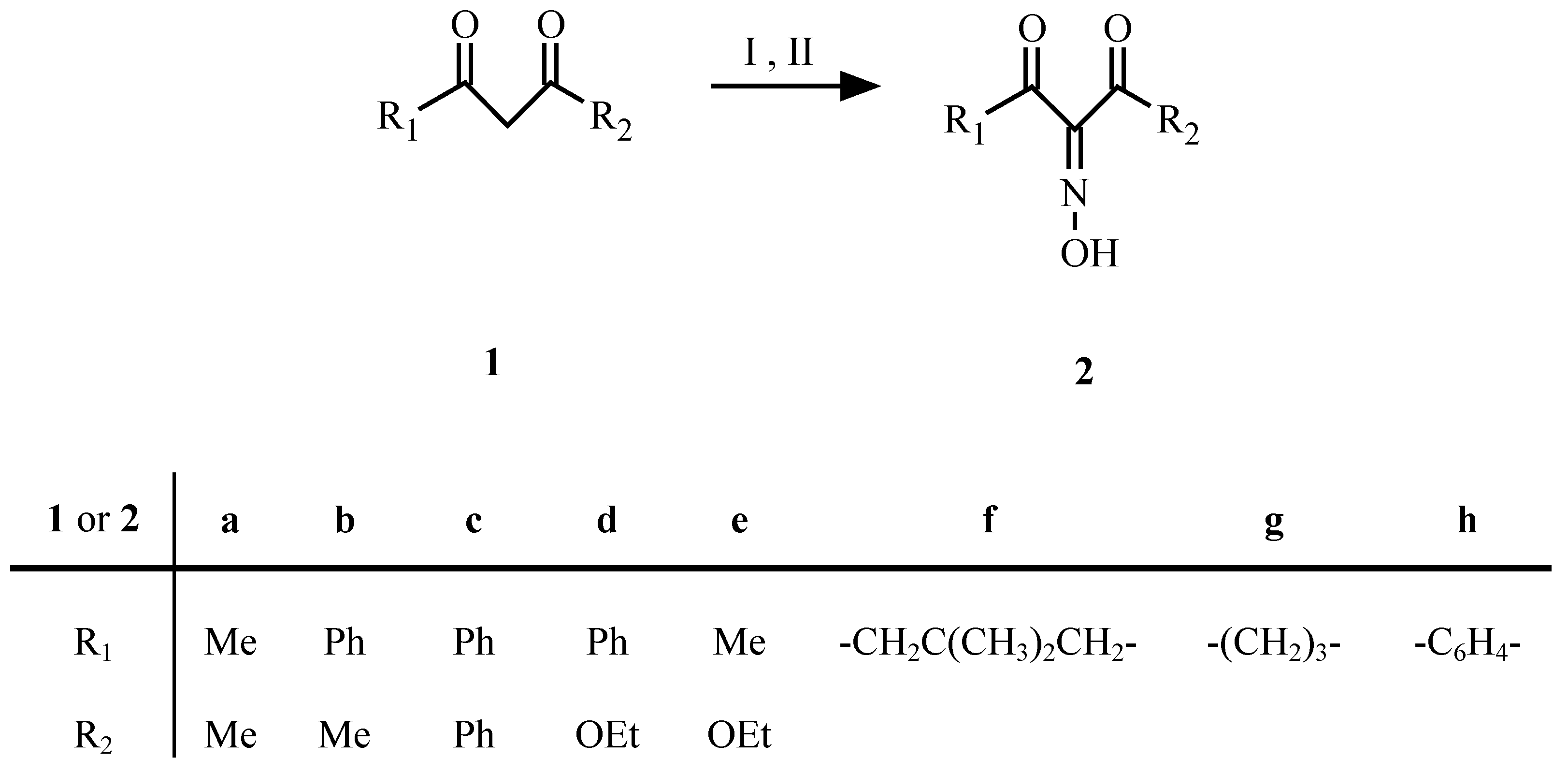An Efficient and Chemoselective Method for Oximination of β-Diketones Under Mild and Heterogeneous Conditions
Abstract
:Introduction
Results and Discussion

| Entry | 1 | 2 | (mmol)a | Time (h) | Yieldsb % | ||
|---|---|---|---|---|---|---|---|
| 1 | a | a | 1 | 2 | 2 | 1 | 88 |
| 2 | b | b | 1 | 6 | 6 | 1 | 86 |
| 3 | c | c | 1 | 7 | 7 | 1.5 | 75 |
| 4 | d | d | 1 | 12 | 12 | 3 | 81 |
| 5 | e | e | 1 | 12 | 12 | 2.5 | 84 |
| 6 | f | f | 1 | 2 | 2 | 1 | 88 |
| 7 | g | g | 1 | 2 | 2 | 0.25 | 90 |
| 8 | h | h | 1 | 2 | 2 | 2 | 50 |

Experimental
General
General Procedure for Oximination of β-Diketones
Acknowledgments
References
- McOmie, J. F. W. Protective Groups in Organic Chemistry; Plenum Press: London and New York, 1973; pp. 46–47. [Google Scholar]
- Cameron, M.; Gowenlock, B. G.; Boyed, A. S. F. J. Chem. Soc. Perkin Trans. 2 1996, 2271.
- Veronese, A. C.; Vecchiati, G.; Orlandini, P. Synthesis 1985, 300.
- Fuson, R. G. Reaction of Organic Compounds: a Textbook for the Advanced Student; John Wiley & Sons, Inc: New York, 1962; pp. 535–538. [Google Scholar] Touster, O. Org. Reactions 1953, 7, 327–378. Wagner, R. B.; Zook, H. D. Synthetic Organic Chemistry; John Wiley & Sons, Inc.: New York, 1953; pp. 739–745. [Google Scholar]
- Kim, Y. H.; Park, Y. J.; Kim, K. Tetrahedron Lett. 1989, 30, 2833. [CrossRef]
- Graham, A.; Williams, D. L. H. J. Chem. Soc. Perkin Trans. 2 1992, 747. Iglesias, E.; Williams, D. L. H. J. Chem. Soc. Perkin Trans. II 1989, 343. Roy, P.; Williams, D. L. H. J. Chem. Research (s) 1988, 122. Leis, R. J.; Pena, M. E.; Williams, D. L. H.; Mawson, S. D. J. Chem. Soc. Perkin Trans. II 1988, 157.
- Zolfigol, M. A.; Kiany-Borazjani, M.; Sadeghi, M. M.; Mohammadpoor-Baltork, I.; Memarian, H. R. Synth. Commun. 2000, 30, 551. Zolfigol, M. A.; Kiany-Borazjani, M.; Sadeghi, M. M.; Memarian, H. R.; Mohammadpoor-Baltork, I. Synth. Commun. 2000, 30, 2945. Zolfigol, M. A. Synth. Commun. 1999, 29, 905. Zolfigol, M. A.; Nematollahi, D.; Mallakpour, S. E. Synth. Commun. 1999, 29, 2277. Zolfigol, M. A.; Mallakpour, S. E. Synth. Commun. 1999, 29, 4061. Zolfigol, M. A. Synth. Commun. 2000, 30, 1593. Zolfigol, M. A.; Ghaemi, E.; Madrakian, E.; Kiany-Borazjani, M. Synth. Commun. 2000, 30, 2057. Zolfigol, M. A.; Kiany-Borazjani, M.; Mallakpour, S. E.; Nassr-Isfahani, H. Synth. Commun. 2000, 30, 2573. Zolfigol, M. A.; Madrakian, E.; Ghaemi, E. Indian J. Chem. 2000, 39B, 308. Zolfigol, M. A.; Ghaemi, E.; Madrakian, E. Synth. Commun. 2000, 30, 1689. Zolfigol, M. A.; Kiany-Borazjani, M.; Sadeghi, M. M.; Mohammadpoor-Baltork, I.; Memarian, H. R. Synth. Commun. 2000, 30, 3919. Zolfigol, M. A.; Shirini, F.; Ghorbani Choghamarani, A.; Taqian-nasab, A.; Keypour, H.; Salehzadeh, S. J. Chem. Research (S). 2000, 420. Zolfigol, M. A.; Zebarjadian, M. H.; Chehardoli, G.; Mallakpor, S. E.; Shamsipur, M. Tetrahedron 2001, 57, 1627. Zolfigol, M. A.; Zebarjadian, M. H.; Chehardoli, G.; A.; Keypour, H.; Salehzadeh, S.; Shamsipur, M. J. Org. Chem. 2001, 66, 3619.
- Rogic, M. M.; Vitrone, J.; Swerdloff, M. D. J. Am.Chem. Soc. 1977, 99, 1156.
- Mallakpour, S. E.; Zolfigol, M. A. Indian J. Chem. 1995, 34B, 183.
- Ford, B. W.; Watts, P. J. Chem. Soc. Perkin Trans. 2 1974, 1009.
- Sample availability: Not available.
© 2001 by MDPI (http://www.mdpi.org). Reproduction is permitted for noncommercial purposes.
Share and Cite
Zolfigol, M.A. An Efficient and Chemoselective Method for Oximination of β-Diketones Under Mild and Heterogeneous Conditions. Molecules 2001, 6, 694-698. https://doi.org/10.3390/60800694
Zolfigol MA. An Efficient and Chemoselective Method for Oximination of β-Diketones Under Mild and Heterogeneous Conditions. Molecules. 2001; 6(8):694-698. https://doi.org/10.3390/60800694
Chicago/Turabian StyleZolfigol, Mohammad Ali. 2001. "An Efficient and Chemoselective Method for Oximination of β-Diketones Under Mild and Heterogeneous Conditions" Molecules 6, no. 8: 694-698. https://doi.org/10.3390/60800694




